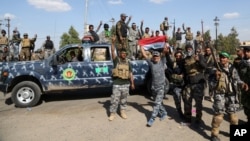While U.S. and coalition partners pluck intelligence on Islamic State extremists from the militants’ communications or movements and then bomb them from the air, the militant group is gathering its own intelligence from city streets and preparing the ground for its next battlefield moves.
The result, according to experts, is that Washington is consistently lagging behind in its effort to destroy the Islamic State group.
“We are about 60 to 90 days behind ISIS,” former intelligence officer and military adviser Michael Pregent told VOA, referring to the Islamic State by one of its acronyms.
Last year when Washington finally paid attention to Mosul, Pregent said, the extremists were already planning their next move. And this pattern has repeated itself as IS has moved across Iraq: “We are now looking at Ramadi, and ISIS is looking ahead at pushing into Baghdad,” he said.
Pentagon’s CENTCOM spokesman, Colonel Patrick Ryder, defended U.S. airstrikes. “We’ve demonstrated the ability to put ordinance on a target within minutes,” he said.
Sleeper cells
But Iraqi President Fuad Masum, in an exclusive interview with VOA, said that the Islamic State’s intelligence sources make them hard to defeat.
“Eliminating Daesh is not easy, because they have many types of sleeping cells, not only in Iraq, but in other countries, too,” Masum said, using the acronym for Islamic State's Arabic name.
Many Iraqi cities have mixed Sunni-Shi’ite populations. Pregent said IS sleeper cells are in traditionally Sunni neighborhoods. These “cells” could be groups or individuals not necessarily affiliated with the Islamic State, but willing to provide the extremists with information.
“They would provide information on whom ISIS could likely work with, whom they need to intimidate, whom they need to kidnap, whom they need to coerce and whom they need to curry favor with, and what Iraqi security forces are willing to do, what their disposition and presence is,” Pregent explained.
Harleen Gambhir, a counterterrorism analyst at the Institute for the Study of War, agreed that IS has a robust internal and external intelligence apparatus, part of which is used to gauge the strength of the Iraqi military and other security forces.
“We do know that they have tried to gather as much intelligence as they can about the Iraqi security forces, and frequently try to kidnap, interrogate and execute members of those militaries,” Gambhir said. Islamic State extremists then use that information to plan their assaults.
Misleading tactics
In addition, according to Jennifer Cafarella, a fellow at the Institute for the Study of War, the extremist group has become adept at misinformation and diversionary tactics. “ISIS can mold, and shape, and mislead its followers if it needs to do that as a tactic to draw attention elsewhere,” said Cafarella.
“We do see these kinds of shaping operations across both Iraq and Syria in ways that don’t necessarily directly portray the image of what ISIS will go for next, because it does have that initiative to set conditions somewhere and then conduct a surprise attack on an additional front,” she said.
Pregent said the United States simply does not have enough assets on the ground to get valuable intelligence on the Sunni extremists.
Syria has become a morass of various competing government, rebel and extremist groups. And the Iraqi intelligence services that conduct raids, round up Sunni males, torture and interrogate them are mainly Shi’ite, Pregent said. “It’s pretty much a blunt instrument.”










